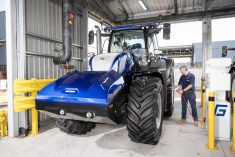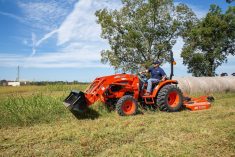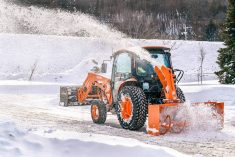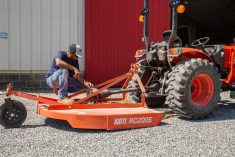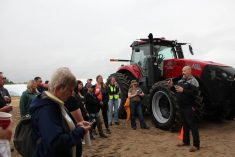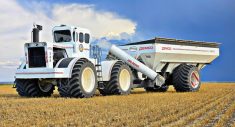The major ag equipment manufacturers have made no secret of the fact they’ve been looking closely at the developments to come out of small startup firms in the technology sector. Some of those small startups have already been purchased or have partnered with the big names, and their groundbreaking technology has been incorporated into some of the equipment now available — or soon to be available — from familiar brands.
One startup firm in Saskatchewan that may not have caught the attention of the majors or become a household name — at least not yet — has been working on creating a generic self-driving system that can be installed on a wide range of tractors. Its name is Mojow Autonomous Solutions, and its co-founder and president, Owen Kinch, already has several years of experience in the R&D of autonomous ag equipment. He was involved in the original development of the autonomous DOT farm equipment platform, which was purchased by Raven Technologies a couple of years ago.
Kinch, who also farms in Saskatchewan, told Grainews he sees autonomy as a key technology that will grow in importance on farms as the pool of labour available to large-scale operators continues to dwindle down.
Read Also

Harvest wraps up and fall work begins
At the Eppich famly ranch in western Saskatchewan, the fall harvest was successful with few breakdowns, cows and calves have been sorted and a new tractor has arrived
“It’s not getting any better,” said Kinch of the farm labour shortage. “It’s worse every year.”
Aside from solving a manpower problem, he added, the high-tech angle of machine autonomy and systems automation might hold a strong appeal to a new generation and keep them interested in farming.
“I have two young children and I try to keep them interested in the farm,” Kinch said, adding when his daughters saw the test rig tractor the first time, they were able to start it by using the Mojow smartphone app. “I’ve never seen my girls get so excited,” he said. “The next generation is always on their phones. That’s how their lives are.”
That app Kinch was referring to is the control for his young firm’s first autonomous test system mounted on a Case IH Magnum tractor. Field trials began on the system two years ago.
“(The year) 2021 was our first year out in the field, and we completed 1,000 acres of heavy harrowing,” Kinch explained. “It was really good experience for myself and the team. The first thousand acres is always the toughest. After that, it starts to get a little easier.”
When the test rig was displayed at the Ag in Motion farm show in Langham, Sask., last July, it already had 2,000 autonomous acres under its belt in the 2022 season. The Mojow team was hoping to work another 8,000 acres by the end of the year.
The tractor’s autonomous system was programmed to operate with a land roller or heavy harrow. The Mojow development team wants to have it do more than just work A-B lines in the field. The end goal is to see the tractor leave the farmyard, set up the implement, do the job and return home, all without direct human supervision.
“Our goal is we want to demonstrate in 2023 a start with the land roller,” said Kinch. “We want to start in our yard, exit the work yard, drive down the roads, get into the right field, unfold the roller and get into the working position and complete the job. Then go to the next field, complete that job, and come home at the end of the day without any human involvement. Those are our goals over the next year.”
Eyebox system
The Mojow team has written its own software program for the autonomous system, and it also built its own hardware package, using components sourced from a number of different suppliers.
“The system itself is called Eyebox,” said Kinch. “The software is completely built in-house. We build our own hardware. We source the sensors from various manufacturers. We stitch them together on a carrier board we produce and seal … in a protective enclosure. So, we’re able to reduce the costs.”
Eyebox uses a variety of sensors to create a real-time representation of the tractor’s environment. The software allows the system to make operating decisions based on that data.
“The kit contains a multitude of sensors, but the most important one is a camera,” Kinch said. “That camera captures images at 10 to 30 frames per second. We run those images through our detection algorithms and identify objects or conditions of interest. We use that information to create what’s known as a digital map, which is just a digital representation of the real world. The computers can make sense of that information and work with it.
“We are able to bring in all that rich image data in real time, and we can use that,” he added. “If we need to alter our A-B line (to avoid obstacles) in real time, we can.”
So far, the development team has been working with a quad, trucks, power poles and various objects like large rocks to train the system to avoid hazards and keep working, rather than stopping and waiting for a person to come and restart the operation. “We’ve had a lot of good success,” Kinch said.
When Kinch and his team demonstrated their system at Ag in Motion last July, they were looking for additional farmers in the Saskatoon to Edmonton corridor region to participate in the continuing R&D effort by allowing Mojow to operate autonomous tractors on their farms under their field conditions.
To learn more about the autonomous tractor project or to contact the Mojow team, go to mojow.ai.




